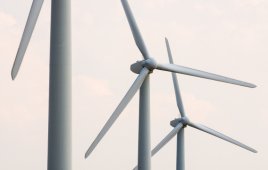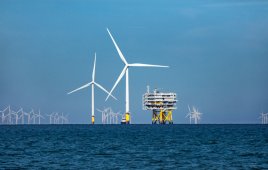Editor’s note: This article comes from an ExxonMobil poster presented at the AWEA Windpower 2017 conference and trade show
Equipment reliability is critical to the success of any wind operation, as unplanned downtime can have a major impact on overall performance, profitability, and safety.
One study showed that a single gearbox failure can result in up to:
- 52% loss in annual energy production
- 55.2% increase in unscheduled wind turbine (WT) downtime1
- 300+ foot climb. Any trip up tower also poses a safety risk: in annual energy production to the turbine hub, an enclosed space2
Proper lubrication is fundamental to equipment reliability, so implementing the right lubrication strategy can help deliver long-term results.
Prioritize formulation over mitigation
When it comes to long-term lubricant performance, there has been increased focus on mitigation strategies – such as top treating WT gearbox oil to mitigate lubricant degradation and extend oil life – over a focus on initial lubricant formulation.
Operators should instead use an oil formulated with the right mix of advanced base oils and additives to deliver long-lasting performance.
These high-quality formulations are designed to protect WT equipment from common issues such as scuffing, micropitting fatigue, and rust and corrosion protection. They also ensure proper protection at extremely high temperatures and good pumpability at low temperatures.
The best-formulated oils will last years longer than conventional lubricants. Some oils today have been proven to perform reliably for up to seven years, demonstrating the capability to protect the machine even after 60,000 hours in service.
When it comes to wind turbine equipment, the most important consideration should be lubricant formulation. By selecting the right lubricants, operators will be better protected in the long run and won’t need to take risks with top treating.
Potential for an unbalanced formulation:
Additive top treating may introduce new contaminants that could impact equipment performance by generating an unbalanced lubricant formulation. For example, surface active additives like anti-wear additives and rust inhibitors both compete for space on the metal surfaces in a gear box. Formulating an oil so that both of these additives are present in the correct amounts is a delicate balance. Topping up with different ratios or different types of these additives could disturb the balance, creating more potential harm than good.
Increased safety concerns:
Top treating oils with additives increases how often operators have to interact with their equipment. While top treating may not be as invasive as flushing and replacing an oil, regular additive top treating requires more frequent equipment interaction, which increases the potential for safety issues. The longer you can rely on your lubricant to perform reliably in-service without the need for maintenance, the better for your staff and operation.
What is top treating?
Proper condition monitoring identifies when an oil’s additives start to deplete and then re-additize that oil with after-market additive packages. While oils will eventually start to deplete additives, inserting additives once the oil is already in service may introduce potential complications.
For further reading:
1 Feng Y, Qiu Y, Crabtree C, Long H, Tavner P. Monitoring wind turbine gearboxes. Wind Energy July 2013. https://www.researchgate.net/publication/235652294_
Monitoring_wind_turbine_gearboxes Access 10 March
2017
2 Slaven I, Dennis E. Developing a technician training course. Professional Safety February 2012. http://foundation.asse.org/docs/ASSE_Wind_Turbine_S
afety_12.pdf Access 10 March 2017
Filed Under: Lubricants, O&M




